|
Counting Our Blessings
Brite Divinity School celebrates turning 90.

By Renee Jones
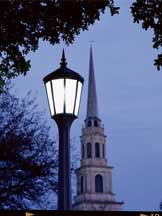 Brite Divinity School provides a distinctive ministerial education because of its relationship to the Christian Church (Disciples of Christ). The denomination was born out of a movement for the unity of
Christians. They believed that a united church would give witness to the power of God's love
in Jesus to make friends of enemies, to bring about reconciliation and healing in this world. Brite embraced that devotion. Brite racially integrated its program in 1952.
It currently shares a Jewish studies program with TCU. Leaders at Brite have a history of risk-taking, of being willing to step up and make hard choices when others weren't sure it was such a good idea. From the first step of adapting Bible education to a more professional, changing world, Brite continues to develop an awareness of the heritage, resources, challenges, and international and religiously diverse context in which pastors, educators and
counselors minister to the world. Brite Divinity School provides a distinctive ministerial education because of its relationship to the Christian Church (Disciples of Christ). The denomination was born out of a movement for the unity of
Christians. They believed that a united church would give witness to the power of God's love
in Jesus to make friends of enemies, to bring about reconciliation and healing in this world. Brite embraced that devotion. Brite racially integrated its program in 1952.
It currently shares a Jewish studies program with TCU. Leaders at Brite have a history of risk-taking, of being willing to step up and make hard choices when others weren't sure it was such a good idea. From the first step of adapting Bible education to a more professional, changing world, Brite continues to develop an awareness of the heritage, resources, challenges, and international and religiously diverse context in which pastors, educators and
counselors minister to the world.
1895 -- The Clark brothers took a risk in 1895 that became visionary. At a time when the Disciples of Christ weren't comfortable mixing Bible and academic theology, the Clarks hired James B. Sweeney to teach sacred literature and history for Add-Ran Christian University, then housed at Thorp Spring.
The founding fathers of the Disciples church thought ministerial training should be focused solely on scripture and saw theological education as human speculation rather than a good model for preparing ministers.
The Clarks realized the need for more professional education for their ministerial students and gave Sweeney, the second preacher in 1885 to graduate from Add-Ran, the title of dean of the Bible College. The title was loftier than the reality in an era of apprenticeship and country schools as it was still actually a department. Sweeney blended the classical Bethany College model, which included a thorough grounding in the Bible, with the practical Lexington model, which emphasized professional education as the basis for the strong and fully accredited Bible college it became in 1914.
1911 -- It was a great year of growth for the department as two major gifts provided housing and an endowed professorship.
Professor G. A. Llewellyn, dean of the Bible College at the time, knew they needed to offer adequate housing to ministerial students, who in those days weren't looking at much more than a meager wage and living on faith. He secured $5,000 from Mrs. M. A. Goode of Bartlett to build a dormitory. Goode Hall was later razed and replaced by Clark Hall, constructed in 1958.
That same year Lucas Charles (L.C.) Brite and wife Eddie, a successful ranching couple in Marfa, donated $25,000 to endow a chair in English Bible. The Brite's relationship with the Clarkes began in 1897 when Eddie and L.C. heard Addison Clark preach and were converted.
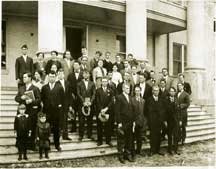 1914 -- Brite College of the Bible is officially incorporated, a 50-year charter is drafted and the faculty and students anticipate a move into a brand new home, above, made possible by an additional $37,500 donated by the Brites that year. (The building now houses the School of Education.) Colby D. Hall is named dean of Brite College. Under the charter, the college is part of TCU but has a separate endowment and board. The two didn't run separate capital campaigns, however. In those early years, capital was hard enough to come by without both Brite and TCU competing for the same dollars. 1914 -- Brite College of the Bible is officially incorporated, a 50-year charter is drafted and the faculty and students anticipate a move into a brand new home, above, made possible by an additional $37,500 donated by the Brites that year. (The building now houses the School of Education.) Colby D. Hall is named dean of Brite College. Under the charter, the college is part of TCU but has a separate endowment and board. The two didn't run separate capital campaigns, however. In those early years, capital was hard enough to come by without both Brite and TCU competing for the same dollars.
Following World War II -- Ministerial education at Brite exploded into its golden age. America grew with the baby boom and a boom in church attendance. It needed more ministers, and both college graduates and those returning from the war filled Brite's classrooms.
McGruder Ellis Sadler presided over TCU from 1941-1959 as president and from 1959-1965 as chancellor, and there was a series of Brite deans like D. Ray Lindley, Roy Snodgrass and Elmer Henson during that time. Enrollment doubled and the faculty expanded dramatically.
Graduates from those days had remarkably distinguished ministries. From 1947-1949 the school trained many of the future leaders of the Christian Church including a future chancellor, a dean of Brite, a general minister and president of the Christian Church, and a generation of distinguished pastors and church leaders.
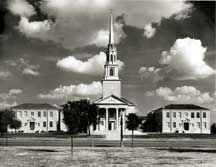 1954 -- TCU's spiritual heart, Robert Carr Chapel, opened this year. Adminstrators realized in the '40s they needed a new religion center, but it wasn't until Eddie Brite, a Brite trustee in her seventies by then, once again showed the foresight and faith to make a change. Board members were unwilling to break ground for a new center without the money in hand. Mrs. Brite stood during a meeting and told them to go ahead. She would make sure they got the money. Robert Carr was also in that meeting. Her promise triggered Carr to jump up and pledge to build the chapel. 1954 -- TCU's spiritual heart, Robert Carr Chapel, opened this year. Adminstrators realized in the '40s they needed a new religion center, but it wasn't until Eddie Brite, a Brite trustee in her seventies by then, once again showed the foresight and faith to make a change. Board members were unwilling to break ground for a new center without the money in hand. Mrs. Brite stood during a meeting and told them to go ahead. She would make sure they got the money. Robert Carr was also in that meeting. Her promise triggered Carr to jump up and pledge to build the chapel.
1950s -- A new quandary arose at Brite when married students began enrolling at the end of World War II. Until then preacher boys got their education, got married, then went off to their ministries. Now they were coming with a wife in tow. Brite had always been committed to the welfare of its students, but this was a puzzle. Dormitories were strictly for single students. Administrators wondered whether they should encourage this trend of getting married early by providing housing.
In a move that continued the spirit of provision and innovation set early in the formation of Brite, they built quadriplex apartments (shown above and below) on the southeast side of the campus along Bowie, now parking lots. It made Brite one of the first schools to provide married student housing, and the quads were innovative.
1960s -- If the 1950s were a time of revival and renewal in American Christianity, the '60s were a turning point. The trend of church attendance reversed, and it hasn't turned around yet. The percentage of Americans who are identified with a religious organization today is about one-third less than it was in the 1960s. It's gone down every year since 1965 without an upturn, so Brite's enrollment dropped dramatically.
1963 -- The original charter of Brite College of the Bible was renewed as "perpetual," and the name was changed from Brite College of the Bible to Brite Divinity School.
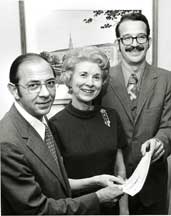 1966 -- William E. Tucker '56 returned to Brite as assistant dean and implemented an effective recruitment program that turned enrollment upward again. When Tucker was promoted to dean of Brite in 1971, he convinced Chancellor James M. Moudy that it would be a good thing for Brite to launch its own capital campaign. The endowments over the years were shrinking against the cost of running what was becoming a major seminary. That capital campaign, which raised $8.5 million, helped make Brite the strong institution it is today. 1966 -- William E. Tucker '56 returned to Brite as assistant dean and implemented an effective recruitment program that turned enrollment upward again. When Tucker was promoted to dean of Brite in 1971, he convinced Chancellor James M. Moudy that it would be a good thing for Brite to launch its own capital campaign. The endowments over the years were shrinking against the cost of running what was becoming a major seminary. That capital campaign, which raised $8.5 million, helped make Brite the strong institution it is today.
1999 -- Brite restated its articles of incorporation and moved to the current interpretation of separate but related status to the university. Until 1999, the head of Brite was called dean and reported through the provost of the university to the chancellor. For 50 years, Colby Hall was both the dean of the University and the dean of Brite, but the days of being able to do that are long gone.
As the university and Brite grew, new structures were needed, so in 1999, the articles of incorporation said Brite would have a president who reported to the Brite board, and an ex-oficio member of the Brite board is the chancellor of TCU. Now Brite is an affiliated school to TCU, not a constituent school to TCU, but the relationship remains vital.

It's a small world.
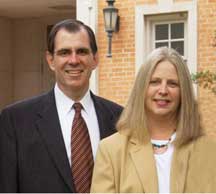 The groundwork for Brite Divinity School was laid in the heart of Miss Eddie Anderson long before she met and married L. C. Brite. She grew up in Missouri and was influenced by a Disciples of Christ minister, E. B. Cake.
Miss Anderson married L. C. Brite, and they moved to Marfa, Texas to raise cattle. In 1897, the Brites heard a sermon by Addison Clark and were was baptized. That early beginning led them to give the $25,000 endowment that established Brite Divinity School.
The great, great granddaughter of E. B. Cake, the Rev. Sue McDougal, is married to the current President of Brite Divinity School, Newell Williams. The groundwork for Brite Divinity School was laid in the heart of Miss Eddie Anderson long before she met and married L. C. Brite. She grew up in Missouri and was influenced by a Disciples of Christ minister, E. B. Cake.
Miss Anderson married L. C. Brite, and they moved to Marfa, Texas to raise cattle. In 1897, the Brites heard a sermon by Addison Clark and were was baptized. That early beginning led them to give the $25,000 endowment that established Brite Divinity School.
The great, great granddaughter of E. B. Cake, the Rev. Sue McDougal, is married to the current President of Brite Divinity School, Newell Williams.

Comment at tcumagazine@tcu.edu.
|



